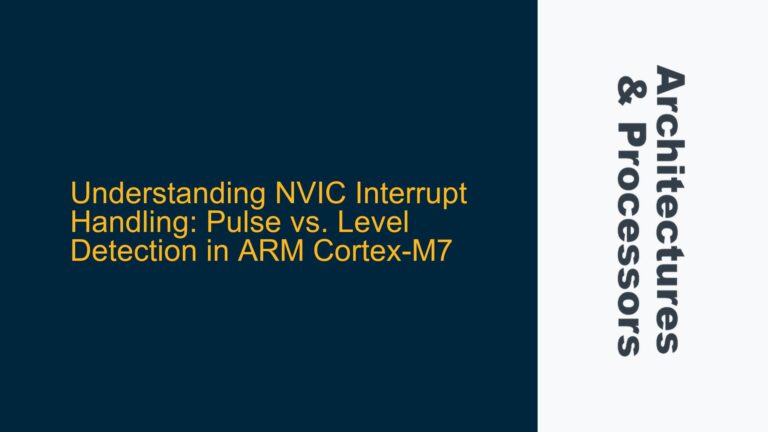ARM Cortex-M4 Flash Memory Access and Instruction Execution Timing
The STM32F405RGT6 microcontroller, based on the ARM Cortex-M4 architecture, exhibits non-linear cycle counts when executing sequences of simple instructions such as NOP and ADD. This behavior is primarily influenced by the interaction between the processor’s instruction fetch mechanism and the flash memory subsystem. The Cortex-M4 core expects single-cycle execution for most instructions, but the reality is more complex due to the flash memory’s access characteristics and prefetching mechanisms.
The flash memory on the STM32F4 series operates with a 128-bit wide data bus, meaning it fetches 128 bits (16 bytes) of instructions in a single read operation. This fetch operation is not instantaneous and incurs a latency that depends on the configured wait states in the FLASH_ACR (Flash Access Control Register). Even with zero wait states, the flash memory read operation takes a finite number of cycles, and the prefetcher introduces additional complexities.
When executing a sequence of instructions, the processor fetches instructions in chunks of 128 bits. For 16-bit instructions like NOP, this means 8 instructions are fetched in one operation. For 32-bit instructions like ADD, 4 instructions are fetched in one operation. The non-linear cycle count arises because the processor must wait for the flash memory to deliver the next chunk of instructions once the prefetched instructions are exhausted. This results in periodic spikes in cycle counts corresponding to the flash memory access latency.
Flash Memory Wait States, Prefetching, and Instruction Fetch Bottlenecks
The primary cause of the non-linear cycle count behavior is the interaction between the Cortex-M4’s instruction pipeline and the STM32F4’s flash memory subsystem. Several factors contribute to this behavior:
-
Flash Memory Wait States: The FLASH_ACR register controls the number of wait states for flash memory accesses. Wait states are necessary to synchronize the flash memory’s response time with the processor’s clock speed. Even with zero wait states, there is a baseline latency for flash memory reads. If the wait states are increased (e.g., due to higher clock speeds), the latency becomes more pronounced.
-
Prefetching Mechanism: The STM32F4 includes a prefetcher that attempts to mitigate flash memory latency by fetching instructions ahead of time. However, the prefetcher operates on fixed-size chunks (128 bits) and cannot perfectly predict the instruction flow. When the prefetched instructions are exhausted, the processor must wait for the next fetch operation, causing a spike in cycle counts.
-
Instruction Width and Alignment: The width of the instructions (16-bit for NOP, 32-bit for ADD) affects how many instructions fit into a single 128-bit fetch operation. This leads to different patterns of cycle count spikes for NOP and ADD instructions. Additionally, instruction alignment within the flash memory can influence the timing of fetch operations.
-
Hidden Board Initialization: In some cases, the board initialization code may modify the FLASH_ACR register to increase the number of wait states or enable additional features like prefetching or data caching. This can further complicate the timing behavior.
-
Debugging Overhead: When using a debugger to measure cycle counts, the debugging process itself can introduce overhead and affect the timing measurements. This is particularly true if the debugger accesses memory or registers during execution.
Optimizing Flash Memory Access and Mitigating Cycle Count Variability
To address the non-linear cycle count behavior and achieve more predictable timing, several strategies can be employed:
-
Use Tightly Coupled Memory (TCM): The STM32F4 includes Core-Coupled Memory (CCM), which is a form of TCM. CCM provides single-cycle access latency, making it ideal for time-critical code. By placing the instruction sequence in CCM, the flash memory access bottleneck can be avoided entirely. However, CCM is limited in size, so it should be reserved for the most critical sections of code.
-
Adjust Flash Memory Wait States: Ensure that the FLASH_ACR register is configured appropriately for the system clock speed. If the clock speed is increased, the number of wait states may need to be adjusted to maintain optimal performance. Use a JTAG debugger to verify the FLASH_ACR settings during runtime.
-
Enable Prefetching and Instruction Caching: The STM32F4’s prefetcher and instruction cache can help reduce the impact of flash memory latency. Ensure that these features are enabled in the FLASH_ACR register. Note that the effectiveness of these features depends on the code’s access patterns.
-
Minimize Debugging Overhead: When measuring cycle counts, minimize the impact of the debugger by using hardware performance counters or dedicated profiling tools. Avoid frequent memory or register accesses during the measurement period.
-
Analyze Instruction Fetch Patterns: Understand how the instruction sequence aligns with the 128-bit flash memory fetch boundaries. For example, grouping 8 NOP instructions or 4 ADD instructions together can help amortize the flash memory access latency over multiple instructions.
-
Use Assembly-Level Optimization: For highly time-critical code, consider writing the sequence in assembly language to ensure precise control over instruction alignment and execution timing. Use data synchronization barriers (DSB) and instruction synchronization barriers (ISB) as needed to enforce proper ordering of memory accesses and instruction execution.
By implementing these strategies, the non-linear cycle count behavior can be mitigated, leading to more predictable and efficient execution of instruction sequences on the STM32F4 microcontroller. Understanding the underlying hardware-software interactions is key to optimizing performance in embedded systems.






